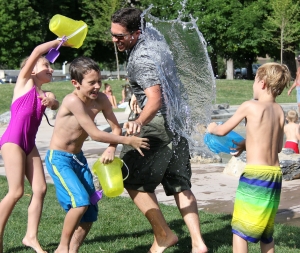Embracing Easter – It’s time to teach play
Most of us can’t decide what we think of the Easter holidays – it seems every bonus comes with its own cost. The camping trip is booked, but will begin with standstill traffic on the Bruce Highway. The chocolate eggs have been hidden, but a secret few will always remain behind the couch (yes, that’s why you have ants). The kids are on school holidays, but the kids are on school holidays.
Having the kids home can fill parents with a mix of joy (think – no school drop-offs, lazy mornings, fun time together) and dread (think – they are there ALL the time, I miss the peace and quiet of work). But, how often do we think of school holidays as a time to teach our kids new skills?
As a parent, you are always your child’s number one teacher! So now the school-bell has rung, it’s back to you to help give your child the skills they need to thrive. I’m not talking about teaching maths and history; I’m talking about teaching play.
Developing good play skills is essential for all children. Play is where we learn tolerance and problem solving, where we express our creativity and healthy competition, and where we develop friendships and explore relationships. While play skills come naturally to some, many children struggle to find their feet in the playground.
Working with children with autism and other social communication challenges, I spend a lot of time in schools teaching kids how to play with their peers. I can get the basics across with books and individual sessions, but the real learning happens out there in the field. You’ll find me hanging out in the sandpit, on the spider web, and at the oval (and yes, I have been told to sit out once before because of the no hat, not play rule). So, how can you get involved and help teach your child how to play this Easter holidays?
Step 1 – Release your inner kid
 We all know that a group of adults and a group of children playing look like different species. If you’re going to help teach your child how to play, you need to find and release your inner child. A few key pointers to look out for – 1) kids don’t talk and explain themselves as much as adults, they just do stuff and get on with it, 2) kids lose themselves in the moment, they’re not pretending to be Spiderman, they are Spiderman, and 3) kids join in on play by announcing their role in the game, not by waiting to be given one (“I’m the postman!”).
We all know that a group of adults and a group of children playing look like different species. If you’re going to help teach your child how to play, you need to find and release your inner child. A few key pointers to look out for – 1) kids don’t talk and explain themselves as much as adults, they just do stuff and get on with it, 2) kids lose themselves in the moment, they’re not pretending to be Spiderman, they are Spiderman, and 3) kids join in on play by announcing their role in the game, not by waiting to be given one (“I’m the postman!”).
If you’re still feeling stuck, take some time to watch how your child, their siblings, friends, and cousins interact when they’re playing.
Step 2 – Brush up on the games
I’m telling you, the field has changed. I’m sad to say, What’s the time Mr Wolf? is getting dusty, and Mr Freeze is the new cool kid on the block. Tiggy/tag and stuck-in-the-mud are still going strong (woohoo!). But, if you don’t know how to recreate a live action version of Minecraft, you’re going to struggle. I recently asked a group of kids to play Red Rover with me and only got blank stares back. Hiding my inner devastation, I took this as a challenge and taught them now to play it – within 10-minutes they had mastered it and I firmly believe their little futures are better for it!
Remember, the internet is a marvellous place where you can look up modern playground games – but this isn’t always necessary. The expert in your child’s playground is sitting right in front of you. Ask you kids what they play at school. If they’re not sure, ask their friends and cousins for some ideas.
Step 3 – Break it down
There are many skills involved in play – watch your child play and see if you can identify what skills they have, and what skills they are missing, to be successful in a particular game. For example, you can’t play tiggy/tag unless you can run – and even then, you’re always going to be “it” if you can’t run very fast, and that’s not so much fun. So if speed isn’t your little one’s strength, start off with some running races to help increase their gross motor skills and teach them how to sprint. Similarly, if you want to be the leader at Mr Freeze you’ll have to call out someone’s name, so if you’ve got a quiet talker, start by practicing using a loud voice by sending silly messages to one another across an oval/park.
One of the key skills to being successful in any game is actually just sticking around. If your little one is a bit of a wanderer and loses interest quickly, teach them how to stay with you for longer and longer. Create a clear play environment (e.g. the Lego mat or playdoh table) and alternate between play- and break-time, gradually increasing the duration of the playtime (e.g. 2-mins, 4-mins, 8-mins, 10-mins) and rewarding them for sticking with you with lots of fun and laughter.

Step 4 – Have fun, always
The take-away message when teaching children play skills is this: playing with others is fun! If they haven’t got that message, you haven’t taught play skills. We need children to absolutely love engaging with us when we’re playing with them, so they’ll want to spend time playing with their peers in the playground. Children’s games are incredibly fun – if you disagree, you just haven’t played them in too long! Lose yourself in the game and laugh along with them.
So while you’re sitting there on the Bruce Highway this Friday, chocolate eggs melting away in the boot, start up a game of Alphabet Number Plates or 20-Questions and enjoy the ride!
Grace works with children, adolescents, and adults at Benchmark Psychology. Grace has a special interest in supporting children with Autism Spectrum Disorders and their families.

 As a parent, supporting your child or teenager through mental health challenges can seem overwhelming. Many parents find themselves wondering – What do I do now? Who can help me?
As a parent, supporting your child or teenager through mental health challenges can seem overwhelming. Many parents find themselves wondering – What do I do now? Who can help me?![Girl Laptop 2 (free comm use)[1]](http://www.benchmarkpsychology.com.au/wp-content/uploads/Girl-Laptop-2-free-comm-use1-300x200.jpg)